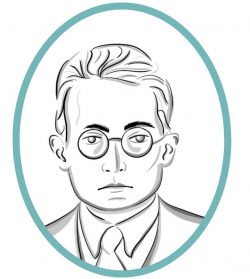Pride profiles: Celebrating LGBTQIA+ figures in SciTech
To celebrate Pride month, to writers from the Boar two of the most influential LGBTQIA+ people in Science and Technology
Dr Alan L. Hart: A ‘visionary figure’ in tuberculosis treatment – Hannah Guthrie
 Alan L. Hart (1890-1962), assigned female at birth, was one of the first documented people to undergo gender-reassignment surgery and the first documented female-to-male (FTM) transition in the United States. He was a physician (radiologist) and novelist, remembered as a “pioneer” and “trailblazer” who “revolutionised” the treatment of tuberculosis (TB).
Alan L. Hart (1890-1962), assigned female at birth, was one of the first documented people to undergo gender-reassignment surgery and the first documented female-to-male (FTM) transition in the United States. He was a physician (radiologist) and novelist, remembered as a “pioneer” and “trailblazer” who “revolutionised” the treatment of tuberculosis (TB).
Hart was among the first doctors to document how TB spread via the circulatory system. Hart’s “ground-breaking contributions to medicine”, proposing using chest x-rays not just to assess TB, but to detect it, meant cases were caught earlier and spread was greatly reduced. He also helped establish screening clinics in rural areas of America.
Prior to his innovation, x-rays were primarily used for assessing TB once patients were already showing severe symptoms. Thanks to Dr Hart, x-rays remain the diagnostic “gold-standard” today.
With x-rays still used to diagnose the disease, Dr Hart’s impact on medicine is acutely felt in the modern world. He has left an enduring legacy, helping to save lives from TB and laying the foundation of medical research for new innovations in disease detection. Dr Hart also wrote many fictional stories over his lifetime, which included autobiographical and medical themes.
Dr Hart spent much of his life hounded by the national press, moving from place-to-place when recognised from these outings in the media. His 1917 transition, which included a hysterectomy, was undertaken by Hart’s University of Oregon Medical School professor Dr J. Allen Gilbert, who anonymously reported it in his 1920 case study “Homo-Sexuality and Its Treatment” in the Journal of Nervous and Mental Disorders. Gilbert concluded that “from a sociological and psychological standpoint [Dr Hart] was a man”. Towards the end of his life, hormones became available to aid his affirmative care, but he lived for the majority of his life without hormonal therapy.
Cristina Fuss, a cardiothoracic radiologist and professor at the same medical school Hart attended, suggests Dr Hart’s life as a transgender man equipped him with the necessary experience to empathise with patients, as TB was a highly stigmatised and isolating disease. Hart is a direct example of how embracing diversity in medicine and science can inspire innovation, discovery, and development.
Tang Feng: The Taiwanese coding genius turned Digital Minister – Georgia Carwardine
 Tang Feng (English name Audrey Tang) is the first non-binary official to be appointed to the executive cabinet in Taiwan, serving as the Minister of Digital Affairs of Taiwan from 2016 to 2024. Tang came out as trans in 2005, and shortly after began hormone therapy. In 2010 they began publicly identifying as non-binary. Tang now identifies as ‘post-gender’ and are comfortable with any pronouns.
Tang Feng (English name Audrey Tang) is the first non-binary official to be appointed to the executive cabinet in Taiwan, serving as the Minister of Digital Affairs of Taiwan from 2016 to 2024. Tang came out as trans in 2005, and shortly after began hormone therapy. In 2010 they began publicly identifying as non-binary. Tang now identifies as ‘post-gender’ and are comfortable with any pronouns.
Tang was also diagnosed with a congenital heart defect at a young age, but despite this, they went on to learn coding at age eight. By 15, they had dropped out of school to start their own IT company.
In 2014, Tang was part of a group of independent hackers called g0v (gov-zero), who had begun protesting, along with hundreds of other young people, a new trade pact that Taiwan made with Beijing, voicing their concerns about the lack of transparency from their government about this new pact. This movement was named the Sunflower revolution. It was at one of this group’s hackathons that the Digital Minister at the time, Jaclyn Tsai, came up with a plan for a neutral platform that would offer citizens the chances to voice their opinions on government actions and decisions. Tang was then appointed as Jaclyn’s right hand, and said themselves: “In Taiwan, the institutions have always taken a ‘we can’t beat them, so we must join them’ approach, which is a rare occurrence in Asian jurisdictions.”
Tang was later tasked with finding a candidate capable of boosting the Taiwanese economy through a “Silicon Valley style” project. However, after attempting to crowdsource this candidate, it was decided that Tang themselves were the most qualified for the role, and they became the country’s youngest ever minister.
After an unconventional yet inspiring career path to become Taiwan’s Digital Minister, Tang is an incredible example of a technological innovator who has campaigned for greater change and transparency from their government through technological pioneering.
Illustrations: Lily Wilson / The Boar

Comments